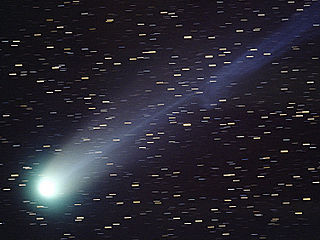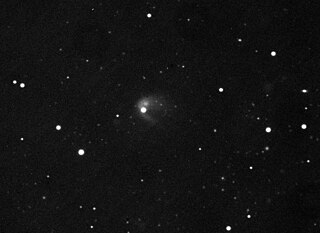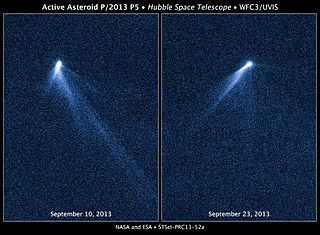
Comet Hyakutake is a comet, discovered on 31 January 1996, that passed very close to Earth in March of that year. It was dubbed The Great Comet of 1996; its passage near the Earth was one of the closest cometary approaches of the previous 200 years. Hyakutake appeared very bright in the night sky and was widely seen around the world. The comet temporarily upstaged the much anticipated Comet Hale–Bopp, which was approaching the inner Solar System at the time.

The Panoramic Survey Telescope and Rapid Response System located at Haleakala Observatory, Hawaii, US, consists of astronomical cameras, telescopes and a computing facility that is surveying the sky for moving or variable objects on a continual basis, and also producing accurate astrometry and photometry of already-detected objects. In January 2019 the second Pan-STARRS data release was announced. At 1.6 petabytes, it is the largest volume of astronomical data ever released.

Active asteroids are small Solar System bodies that have asteroid-like orbits but show comet-like visual characteristics. That is, they show comae, tails, or other visual evidence of mass-loss, but their orbit remains within Jupiter's orbit. These bodies were originally designated main-belt comets (MBCs) in 2006 by astronomers David Jewitt and Henry Hsieh, but this name implies they are necessarily icy in composition like a comet and that they only exist within the main-belt, whereas the growing population of active asteroids shows that this is not always the case.

C/1989 X1 (Austin) was a comet discovered by New Zealand amateur Rodney R. D. Austin on December 6, 1989. The comet at discovery was predicted to become easily visible by naked eye in spring 1990, however it failed to become that bright.

C/2011 L4 (PANSTARRS) is a non-periodic comet discovered in June 2011 that became visible to the naked eye when it was near perihelion in March 2013. It was discovered using the Pan-STARRS telescope located near the summit of Haleakalā, on the island of Maui in Hawaii. Comet C/2011 L4 probably took millions of years to come from the Oort cloud. After leaving the planetary region of the Solar System, the post-perihelion orbital period is estimated to be roughly 107000 years. Dust and gas production suggests the comet nucleus is roughly 1 kilometer (0.62 mi) in diameter.

Comet ISON, formally known as C/2012 S1, was a sungrazing comet from the Oort cloud discovered on 21 September 2012 by Vitaly Nevsky and Artyom Novichonok.

C/2012 K1 (PANSTARRS) is a retrograde Oort cloud comet discovered at magnitude 19.7, 8.7 AU from the Sun on 17 May 2012 using the Pan-STARRS telescope located near the summit of Haleakalā, on the island of Maui in Hawaii (U.S.).

311P/PANSTARRS also known as P/2013 P5 (PANSTARRS) is an asteroid discovered by Bryce T. Bolin using the Pan-STARRS telescope on 27 August 2013. Observations made by the Hubble Space Telescope revealed that it had six comet-like tails. The tails are suspected to be streams of material ejected by the asteroid as a result of a rubble pile asteroid spinning fast enough to remove material from it. This is similar to 331P/Gibbs, which was found to be a quickly-spinning rubble pile as well.
C/2014 G3 (PANSTARRS) is a faint comet discovered on 10 April 2014 by Pan-STARRS which will pass near Jupiter's gravitational field on 8 March 2016 at distance of 0.76 AU. The comet had about a 405-year orbital period before entering the planetary region of the Solar System. The comet will only brighten to around apparent magnitude 18 in 2015, and will require a large amateur telescope with a CCD camera to be detected. After this passage the comet will have a 391-year orbital period. C/2014 G3 has a spectra similar to S-type asteroids.
C/2015 ER61 (PANSTARRS) is a comet, inner Oort cloud object, Amor near-Earth object, and possibly a damocloid. When classified as a minor planet, it had the fourth-largest aphelion of any known minor planet in the Solar System, after 2005 VX3, 2012 DR30, and 2013 BL76. It additionally had the most eccentric orbit of any known minor planet, with its distance from the Sun varying by about 99.9% during the course of its orbit, followed by 2005 VX3 with an eccentricity of 0.9973. On 30 January 2016, it was classified as a comet when it was 5.7 AU from the Sun. It comes close to Jupiter, and a close approach in the past threw it on the distant orbit it is on now.

Comet 252P/LINEAR is a periodic comet and near-Earth object discovered by the LINEAR survey on April 7, 2000. The comet is an Earth-Jupiter family comet, meaning that it passes quite close to both Earth and Jupiter. This causes its orbit to be perturbed frequently on an astronomical timescale.

P/2016 BA14 (Pan-STARRS) is a near-Earth object and periodic comet of the Jupiter family, that was radar imaged at distance of 2.2 million miles during a flyby of Earth in 2016. This enabled the size of the nucleus to be calculated to be about 3000 feet to 3300 ft (1 km) in diameter. Four noted aspects to BA14 are that it was discovered as an asteroid first, it was much bigger than expected going from perhaps 125 meters to 1000 meters, it was the closest approach by a comet since 1770, and finally, it has a very similar orbit as numbered comet 252P/LINEAR, and may be related to it.

(523794) 2015 RR245, provisional designation 2015 RR245, is a large trans-Neptunian object of the Kuiper belt in the outermost regions of the Solar System. It was discovered on 9 September 2015, by the Outer Solar System Origins Survey at Mauna Kea Observatories on the Big island of Hawaii, in the United States. The object is in a rare 2:9 resonance with Neptune and measures approximately 600 kilometers in diameter. 2015 RR245 may have a satellite according to a study announced by Noyelles et al. in a European Planetary Science Congress meeting in 2019.

C/2017 K2 (PANSTARRS) is an Oort cloud comet with a hyperbolic orbit, discovered in May 2017 at a distance beyond the orbit of Saturn when it was 16 AU (2.4 billion km) from the Sun. Precovery images from 2013 were located by July. It has been in the constellation of Draco since July 2007. As of May 2021, the 3-sigma uncertainty in the current distance of the comet from the Sun is ±4,000 km (2,500 mi). The comet is record breaking because it is already becoming active at such a distance, only comet Hale Bopp produced such a show from that distance and having a similar nucleus. However, this comet will not be as visible as Hale Bopp was in 1997, although it will reach naked eye visibility on its perihelion. Astronomers have never seen an active inbound comet this far out, where sunlight is 1/225th its brightness as seen from Earth. Temperatures, correspondingly, are at a minus 440 degrees Fahrenheit (-262 °C) in the Oort cloud. However, as it is approaching the Sun at a distance of 16 AU at discovery, a mix of ancient ices on the surface of oxygen, nitrogen, carbon dioxide and carbon monoxide is beginning to sublimate and shed as dust. This material expands into a vast 130,000 km (81,000 mi) wide halo of dust, called a coma, enveloping the solid nucleus.
A Manx comet is a rocky, minor, celestial body that has a long-period comet orbit. Unlike most bodies on a long-period comet orbit which typically sport long, bright tails, the Manx comet is tailless, more typical of an inner Solar System asteroid. The nickname comes from the Manx breed of tailless cat. Examples include C/2013 P2 (PANSTARRS), discovered on 4 August 2013, which has an orbital period greater than 51 million years, and C/2014 S3 (PANSTARRS), discovered on 22 September 2014, which originates from the Oort cloud and could help explain the formation of the Solar System.

2I/Borisov, originally designated C/2019 Q4 (Borisov), is the first observed rogue comet and the second observed interstellar interloper after ʻOumuamua. It was discovered by the Crimean amateur astronomer and telescope maker Gennadiy Borisov on 30 August 2019 UTC
P/2016 G1 (PANSTARRS) was an asteroid that astronomers believe disintegrated in 2016.

C/2020 F3 (NEOWISE) or Comet NEOWISE is a long period comet with a near-parabolic orbit discovered on March 27, 2020, by astronomers during the NEOWISE mission of the Wide-field Infrared Survey Explorer (WISE) space telescope. At that time, it was an 18th-magnitude object, located 2 AU away from the Sun and 1.7 AU away from Earth.

C/2017 T2 (PANSTARRS) is an Oort cloud comet discovered on 2 October 2017 when it was 9.2 AU (1.38 billion km) from the Sun. The closest approach to Earth was on 28 December 2019 at a distance of 1.52 AU (227 million km). It came to perihelion on 4 May 2020 when it was safe from disintegration at 1.6 AU from the Sun.
C/2014 OG392 is a comet discovered as a centaur on 28 July 2014 when it was 11.5 AU (1.72 billion km) from the Sun and had an apparent magnitude of 21. The comet was relatively easier to detect at this distance because the nucleus is estimated to be 20 km in diameter.





















